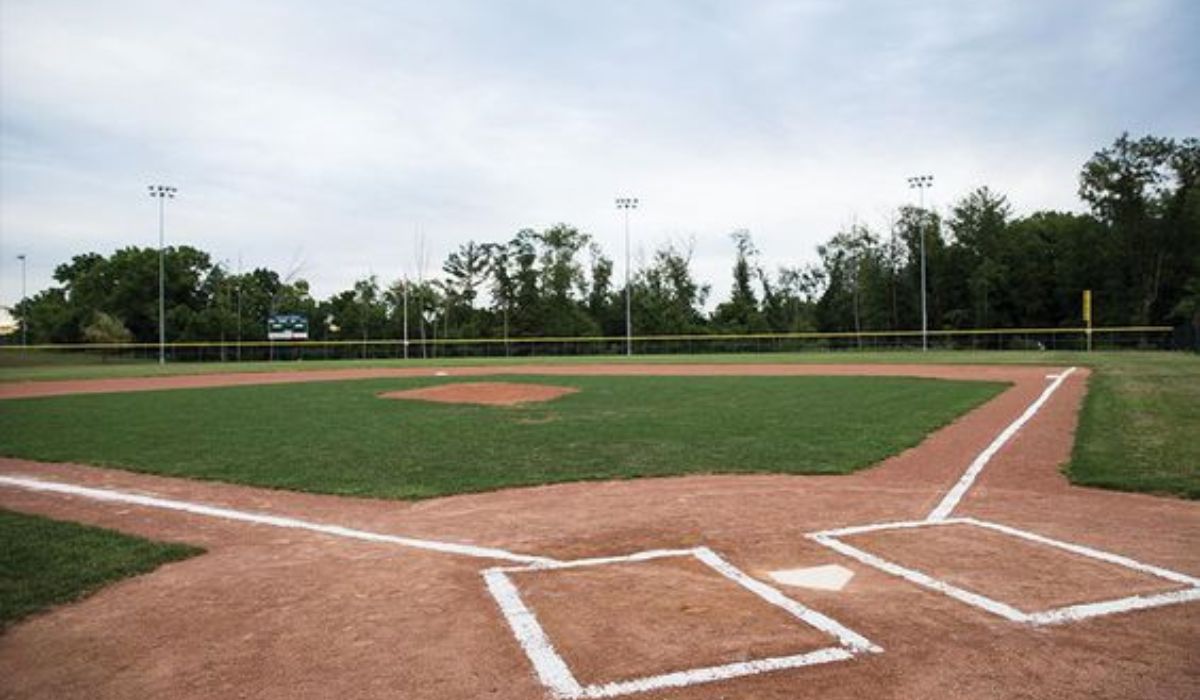
There are about 216,000 baseball fields in the United States. This indicates the sport’s popularity. Keeping these fields in good shape is key for the safety and fun of players and fans. This guide offers top tips to maintain your baseball field, whether it is for a local league or a big stadium.
Key Takeaways:
- Develop a field maintenance plan to ensure proper care and upkeep.
- Implement turf management techniques for a healthy and playable field.
- Select and maintain the right equipment for safety and functionality.
- Consider softball field construction and maintenance for additional insights.
- Follow expert tips to enjoy a well-maintained baseball field for years to come.
Developing a Field Maintenance Plan
Creating a good maintenance plan is key for your baseball field. It makes sure all parts, like base paths and pitcher’s mounds, get the care they need.
“A well-designed field maintenance plan is the backbone of a well-maintained baseball field.”
– Field Maintenance Expert
Consider who will do the work, whether a team or volunteers. Also, figure out what resources and money you have for supplies and equipment.
Use what you’ve got to keep the field in good shape. This means mowing, managing moisture, and leveling areas like the pitcher’s mound.
Regular upkeep of the bullpen areas is also important to maintain the safety and functionality of the field.
Choose the right tools for your field, like mowers and rakes. Make sure they fit your field’s size and need. They should be easy to work with.
Make a regular maintenance schedule. This should cover mowing, watering, and fixing any worn-out areas. Being consistent keeps your field looking great.
Develop a maintenance plan that looks after the field well. This makes sure your baseball field is in top condition for games.
Turf Management
Keeping a baseball field healthy and playable is key. Use good strategies to keep the turf in top condition during baseball season.
Controlling Weeds, Pests, and Disease: An active approach is crucial for a weed-free and disease-resistant area. Regular checks for weeds and pests are important. Use herbicides and pesticides wisely to protect the environment.
Aeration: Aeration is vital for root growth and reducing soil hardness. This process makes small holes in the turf. It helps air, water, and nutrients reach the roots and keeps the turf healthy. Use aerators like solid tine or hollow core for best results.
Renovation or Reconstruction: Turf can get damaged over time, creating bare spots or uneven areas. It’s important to regularly check the turf’s condition and fix any issues. This might mean spreading new seed, adding a top layer, or completely replacing the turf.
Grass Selection: Picking the right grass is essential for the field’s success. Consider the climate, sunlight, and how much the field is used. Talk to experts to pick a grass type that will thrive well.
Irrigation: Good watering is vital to keep the soil moist but not waterlogged. Follow a watering plan based on the weather and soil. Use efficient systems for even watering.
Fertilization: Regular fertilizing with the right nutrients helps the turf grow strong. Test the soil to know what it needs. Choose fertilizers that release nutrients slowly to help the environment.
Follow these tips for a well-cared-for baseball field. This ensures it stays healthy, strong, and looks good for everyone.
Baseball Field Equipment
The proper upkeep of a baseball field links directly with having the correct gear. This includes things like field lights, bases, and backstops. Each item is vital for a safe and polished game setting. Now, we’ll dive into some important baseball field gear and tips for keeping them in top shape.
Field Lighting
Good field lighting is key for night games and ensuring better visibility. You should check and clean the lights often to keep them working well for players and fans.
Bases
Bases are key parts of the field. Make sure to look them over for wear regularly. If they need it, swap them out. Also, always ensure bases are firmly in place to avoid injuries.
Backstop
The backstop keeps spectators safe and balls on the field. Check it often for safety, and fix or change any broken parts. Doing this keeps both your field and your fans safe.
Dugouts
Dugouts are where players and coaches are during games. They should be kept clean and in good shape. Adding a turf mat can prevent damage to the area.
Outfield Fencing
Outfield fencing marks the field’s edge and stops balls. Look for damage and make repairs as needed to keep it secure. Trim plants nearby to avoid blocking gameplay.
Coaches’ Boxes
Coaches’ boxes are for coaches to direct their teams during play. Keep them very visible by maintaining and marking them well. This helps clear up confusion and ensures coaches have a spot to guide from.
Batter’s Eye
The batter’s eye helps hitters see the ball better. Keep it clean and tidy to prevent any visual obstacles for the batter.
Foul Poles
Foul poles decide if a ball is fair or foul. They should be checked often for safety. Keeping them well-marked helps umpires make the right calls.
Warning Tracks
Warning tracks help outfielders know they’re near the fence. Keep them groomed to be clear of debris and in a noticeable color.
Protective Screens
Protective screens keep players safe during practice. Regular checks for tears are essential. Always keep them clean and stored correctly to last longer.
Portable Batting Cages
Portable batting cages make it easy for teams to practice hitting. Always look over the frame and netting for damage. Ensure they are put up safely and securely.
Batting Tunnels
Batting tunnels are great for enclosed batting practice areas. Keeping them clean and well-maintained avoids accidents and ensures a longer lifespan.
Field Signs
Field signs give important info to players and fans. Check them for wear or fading, and switch them out if needed. Clear, clean signs are a big help.
By picking the right baseball field gear and caring for it well, you make a safe and enjoyable playing area. Regular checks, cleaning, and fixes keep your gear effective for many games. Taking care of your equipment is taking care of your team, coaches, and fans.
Softball Field Construction and Maintenance

This guide is mainly about taking care of baseball fields. But let’s not forget softball fields need care too. Softball has its own field sizes and shapes to make sure games are fair and fun.
Building a softball field means sticking to the size rules set by the sports groups. This covers how far the pitcher’s mound is from home plate, how far the bases are from each other, and how big the outfield is. Doing this means your field is ready for official games.
If you’re moving from baseball to softball, keep a metric conversion chart with you. This chart helps switch measurements between the different systems. It makes field work more precise and organized.
Softball fields look different from baseball fields. Bases and the pitching mound are set up in their own special ways. Knowing about these details helps make sure everything is in the right place.
Taking care of a softball field is much like taking care of a baseball field. You still need to cut the grass, keep it healthy, and ward off pests. But, since the grass might be different, your to-do list might change a bit. Using a maintenance checklist can keep you on track.
Building and taking care of softball fields make the games safer and more fun. Stick to the field size rules, use the right tools, follow the layout, and stick to a maintenance plan. This keeps your softball field great for playing and practicing.
If you love softball, knowing how to look after a field is very important. Doing things right makes the field safe and fun for everyone. Following the right steps makes your field a great place for games and fun.
Conclusion
Making sure a baseball field looks good and is safe requires regular upkeep. This guide gives expert advice to keep your field in top shape. It covers everything from making a plan to taking care of the grass and machines.
A good plan means you won’t forget to do things like mow the field or keep the bases clear. It also helps with grooming the dirt areas and looking after the pitcher’s mound and home plate. Following proper ways to manage the grass, like preventing weeds and making sure it gets enough water and nutrients, is key for a strong field surface.
Choosing and caring for equipment is just as important. This includes lights, bases, and dugouts. Regular checks and making fixes when needed help keep everything working well. Doing this keeps the field safe and looking professional.
A well-kept field is not just about the game. It makes players perform better and keeps everyone safe. It also makes a good impression on fans. By using the advice in this guide, you’ll have a great field that everyone will love for a long time.
Recommended
- BASEBALL FLOW HAIRCUT: TRENDY STYLES FOR ATHLETES
- WHY ARE BASEBALL BATS SO EXPENSIVE? UNRAVELING COST
- REGRIP BASEBALL BAT: EASY STEPS FOR BETTER PERFORMANCE

Meet Daniel Anderson, the heart and soul behind Baseball Pro Picks. At 49, Daniel’s life has revolved around baseball, a passion that’s as strong today as it was when he first fell in love with the game. Living in the USA, Daniel has dedicated countless hours to watching, analyzing, and understanding every pitch, hit, and home run, making almost no game missed. His deep-rooted love for the sport is matched only by his commitment to sharing insightful, expert analysis with fellow baseball enthusiasts. With decades of experience and a keen eye for the game’s nuances, Daniel brings a unique perspective that enriches Baseball Pro Picks. Trust Daniel to guide you through the intricacies of baseball with the authority and trustworthiness of a true aficionado.












